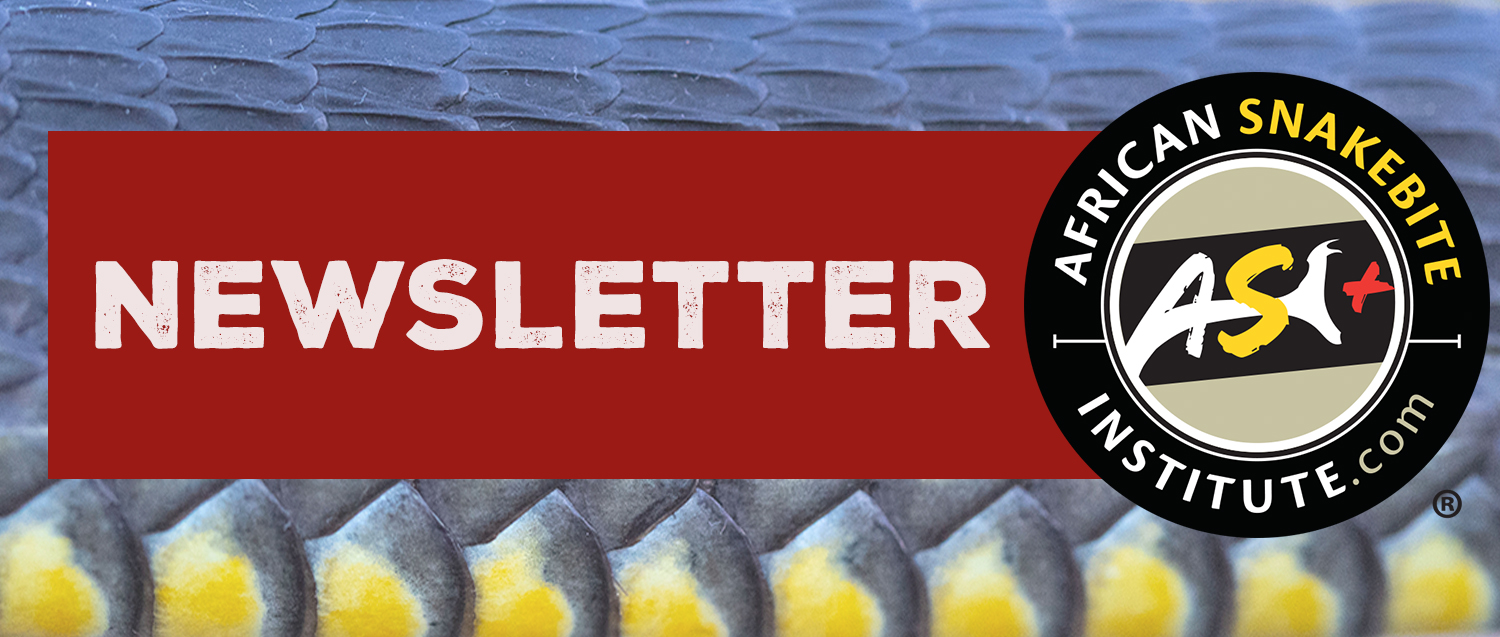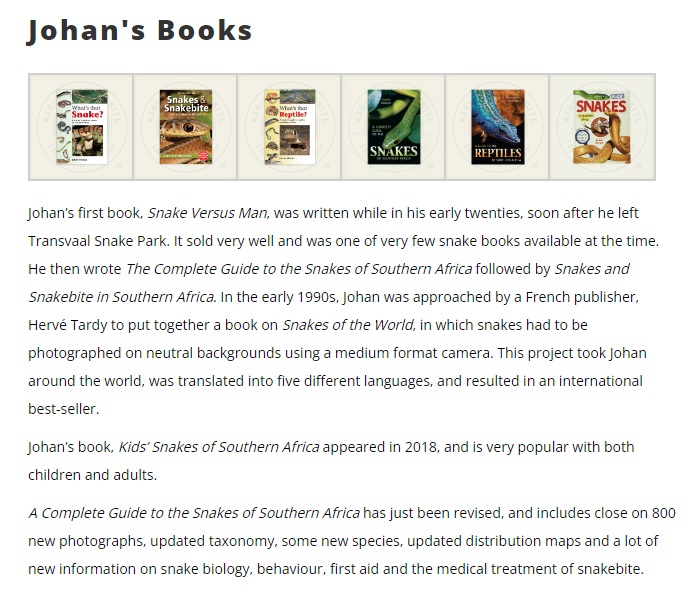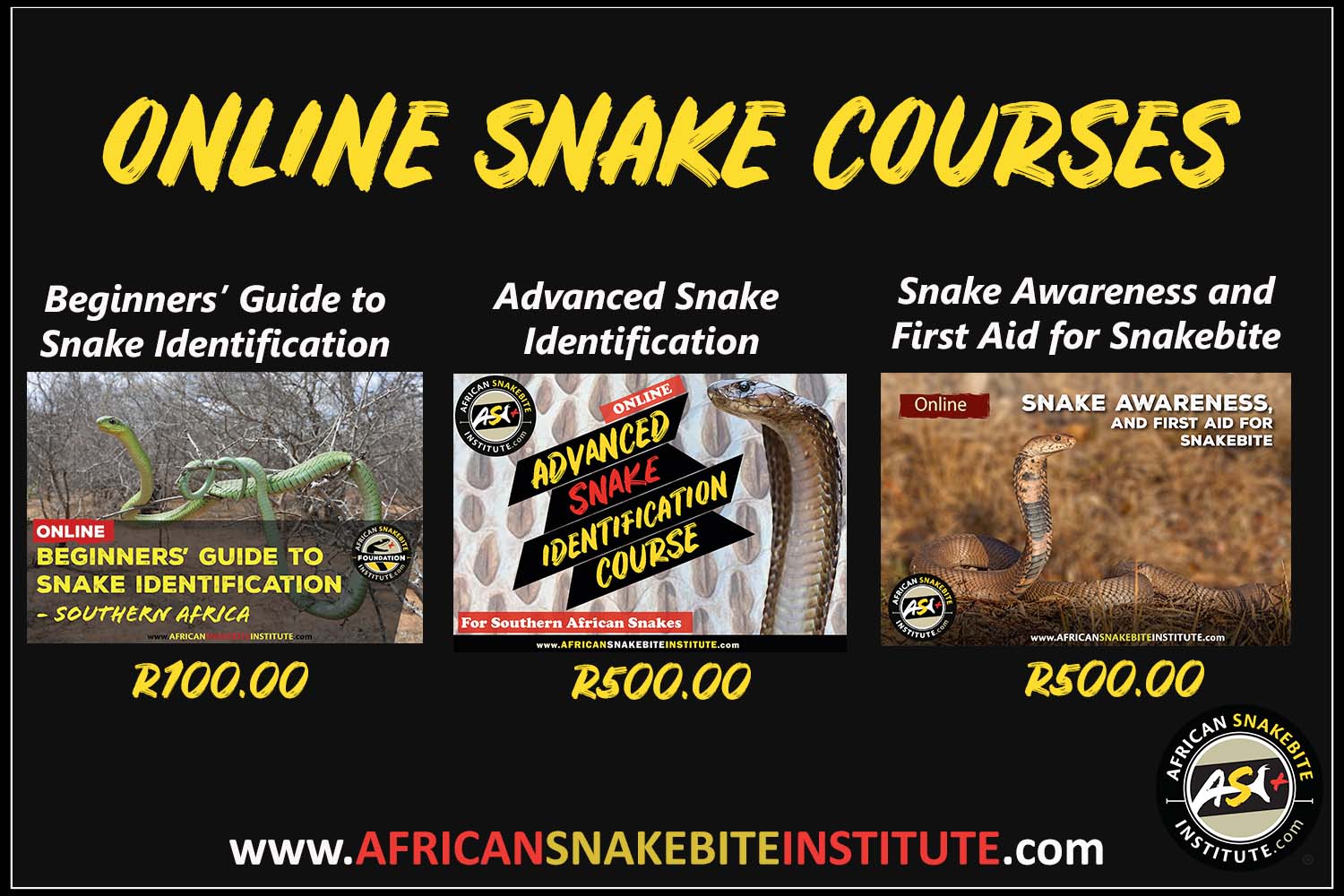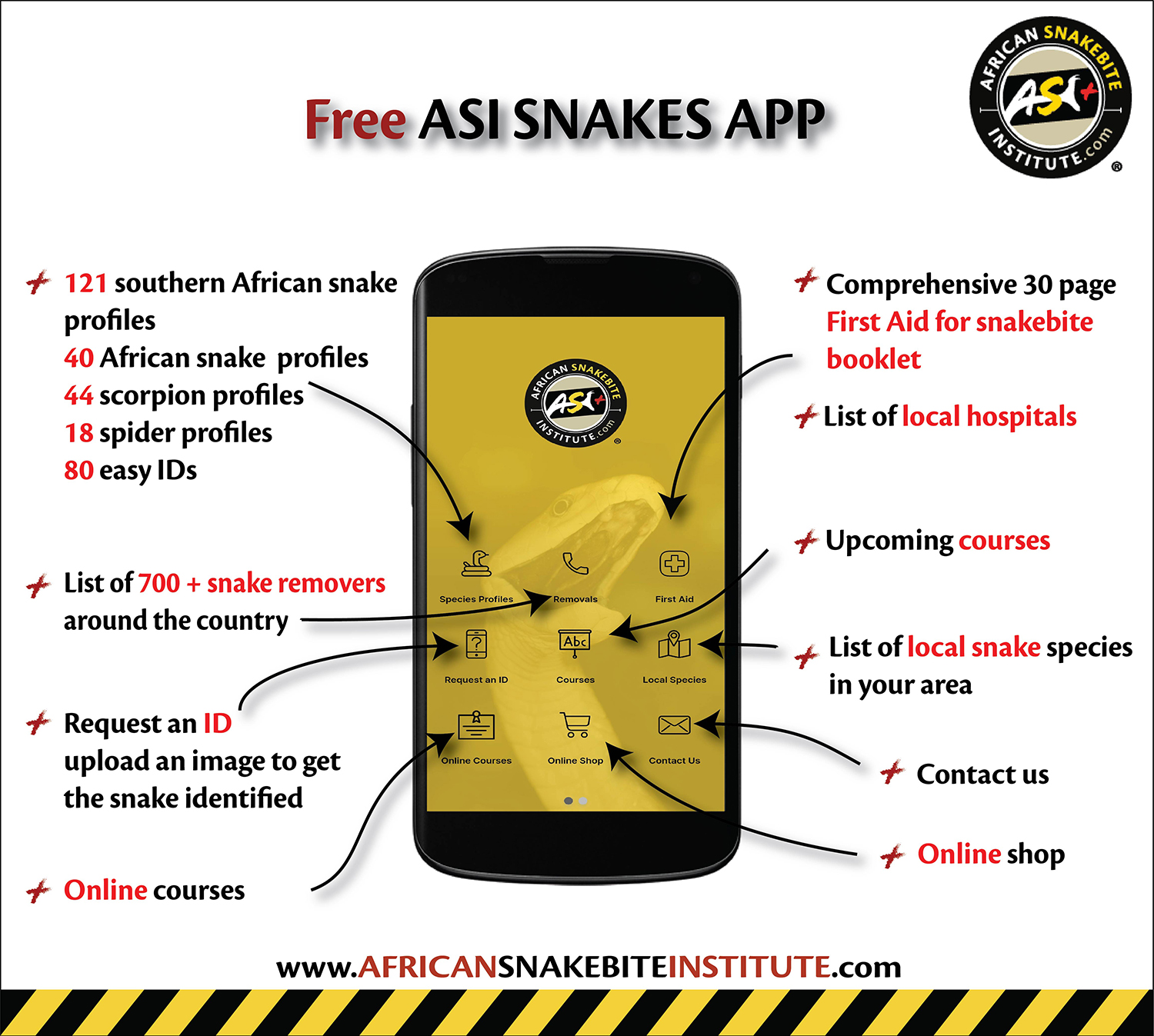|
You are receiving this email because you signed up for the monthly ASI Newsletter.
If you no longer wish to receive these emails you can unsubscribe here
|
 |
|
|
|
Leading snake handling equipment supplier in Africa!
The African Snakebite Institute has been in the snake business for many years.
Our CEO, Johan Marais has been working with snakes for over 45 years and has written numerous books on snakes and other reptiles during that time, including the best-selling A Complete Guide to the Snakes of Southern Africa, which has sold over 100,000 copies and was recently revised.
He has spent vast amounts of time in the field observing and catching snakes and has also managed to travel throughout the world attending snakebite symposia and visiting snake parks and universities. Through the African Snakebite Institute, Johan has also trained thousands of people in snake awareness, first aid for snakebite and safe protocols to remove problem snakes.
|
|
|
 |
|
|
|
We offer on-site corporate snake awareness, first aid for snakebite and venomous snake handling training to companies throughout Africa as well as public courses at various venues across South Africa. The African Snakebite Institute has also developed a number of hugely popular online courses, including basic snake identification, advanced snake identification and snake awareness – and with more in the pipeline.
|
 |
|
On-site corporate training is a vital health and safety precaution for most sites.
|
|
|
|
Our focus is to educate people about snakes – spreading knowledge and accurate information as far as possible, dispelling myths and teaching the best techniques for safe snake removal – none of the sensationalized cowboy antics you see on popular TV shows or YouTube channels. Corporate delegates are not permitted to physically touch snakes and we do not allow them to grab venomous snakes by the tail – far too risky and unnecessary.
|
 |
|
|
|
With both Johan’s vast snake knowledge and business experience we have developed the largest range of quality snake handling equipment in Africa! We now stock over 440 products, including 13 different types of snake tongs, 10 different snake hooks, 18 different types of snake gaiters – and the list goes on an on.
The days of people killing snakes out of ignorance are slowly becoming a thing of the past. The vast majority of people nowadays want to educate themselves, and gaining access to informative and educational resources, like the free ASI Snakes app, is relatively easy. The realization that not all snakes are dangerous, and that they all have a role to play in the ecosystem is sinking in. Some species prove to be hugely beneficial – think of Slug-eaters in a garden or Brown House Snakes where you are inundated with rodents.
|
|
|
|
Whist we teach the proper use of snake handling equipment on all our courses, we understand that not everybody has access to such training, but that they still want to remove snakes safely.
When it comes to choosing snake handling and affiliated equipment – there are a lot of options, and it can become quite confusing.
Below are some basic guidelines to follow, should you be looking at equipping yourself with the correct tool for the job.
|
|
|
|
|
|
Snake tongs (also called: snake grabbers, grab sticks, or snake catchers)
If you are looking at buying snake tongs, what length are you looking for? In other words, what distance from a venomous snake would you be comfortable with? Most people jokingly tell us that 20m would work, but this is an important question. We highly recommend a 1.5 m tong for anyone who is inexperienced in removing snakes.
You can handle anything from a 30cm Mozambique Spitting Cobra to a 2.5 m Black Mamba with a 1.5 m tong. They are short enough (compared to the 2m option) to still do removals in confined spaces like houses and workshops and fit comfortably into a small car. They are also long enough to give you some peace of mind when they make contact with a snake, whose identity and length may be unknown.
Experienced snake removers and snake parks generally make use of the 1 m tongs – mainly because they work in the close confines of snake tanks and these tongs work well for that. They also often need to neck snakes in snake parks and the longer tongs are then impractical. Needless to say, necking (grabbing a snake behind the head) is not recommended when removing problem snakes.
2 m tongs are great for places like game lodges, where they need the length to remove snakes from thatch roofs or from under beds.
What to look out for
Quality – make sure you’re buying a decent set of tongs. There are a lot of cheap Asian imports available from various places and these can be more of a hazard than a help.
Make sure the trigger section closes completely and doesn’t jam. Purchase a tong with at least a 3cm lip on the jaw section – this makes a huge difference to removals as you don’t pinch the snake, and it makes working with larger bodied snakes much easier than those with a short lip.
Avoid heavy tongs, and tongs with metal rods underneath them – the snakes just wrap their tails around this.
Tongs are an investment and if they are well looked after; they will last you many years. Care for your tongs and do not drop them onto concrete floors, from trees or the roof.
In the end, you could spend a bit more on quality tongs or half your life savings in ICU after a bite. Quality snake tongs should cost you far less than R1,500.00 and should come with a guarantee and repair facilities.
|
|
|
|
|
|
Snake hooks
Snake hooks are pretty straight forward and work really well on the large adders. Make sure the “U” of the hook will be big enough for a decent sized snake to fit in comfortably. The “V” hooks generally don’t work well for large adders. Experienced snake handlers use hooks to ‘hook and tail’ a snake, and in that scenario any hook will work. Some handlers even use tongs for this but tailing in not recommended in the corporate environment.
|
|
|
|
|
|
Snake tubes
We make extensive use of snake tubes, both on our courses and for removals. They work well to contain and safely transport venomous snakes. The snake sees the darkness of the tube as an escape route and is easily guided into the tube. When buying a tube, make sure that it is clearly marked, and has ventilation holes in the lid (usually covered by foam for spitting snakes, and to prevent nose rub during transportation) and has a decent handle. Holes down the sides of the tube are not advisable as they let light into the tube.
|
|
|
|
|
|
Snake buckets
The other container we make use of is a snake bucket. We prefer the transparent buckets, so that one can see what the snake is doing. Crumpled newspaper can be put in the bottom of the bucket for the snake to hide under. At all costs avoid square or rectangular tubs. As soon as you put a snake in one of these it finds a corner and goes up and comes straight out.
When buying a snake bucket, make sure it’s clearly marked with a “venomous snake” sticker, has a central handle on the lid (to avoid bites to the fingers), has clips to lock the lid and has ventilation holes. The 70 litre buckets are preferred as you can fit almost any size snake in them.
|
|
|
|
|
|
Eye protection
Eye protection is vital for removals in areas where spitting snakes are known to occur. Venom in the eyes is extremely painful and not worth the risk.
If you want to make use of goggles (or spoggles as they are sometimes called), make sure you purchase ones that seal around the eye area. When snakes spit, they aim for the face and with a small bit of a sweat, the venom that lands on the forehead will run down to the eyes. Also make sure the goggles don’t fog up when wearing them.
The other option is a full-face mask – these work well as they protect the whole face.
|
|
|
|
|
|
Snake gaiters
There are a number of snake gaiters on the market, from entry level budget ones to high end lightweight gaiters. Do not confuse gaiters available from outdoor shops with snake gaiters – they are designed to keep plant seeds off your socks and do not prevent snakebite.
Snake gaiters offer leg protection, and the use of these are advisable, as 84% of snakebites are below the knee. Ideally you want to make sure they are comfortable and easy to walk with.
Those that are quick to put on are great for removal purposes, as one is usually in a hurry. Make sure that the snake gaiters that you purchase are designed to protect users from snakebite and that they have been tested by a reputable company.
|
|
|
|
|
|
Educational resources
The African Snakebite Institute website contains a vast about of information, from snake, scorpion and spider profiles to over 260 snake posters – available as free high resolution downloads from the site. There are also hundreds of informative articles and newsletters to read through.
The African Snakebite Institute has its own highly informative free app called ASI Snakes, which includes snake, scorpion and spider profiles, snake posters, first aid for snakebite information, a list of over 800 snake remover country wide, a section to submit a photo for identification, snake identification quizzes, newsletters, and a whole lot more. (Get the app here)
The African Snakebite Institute Facebook page, as well as our group Snakes of Southern Africa is filled with informative posts and articles.
Snake books
When it comes to snake books, as a fully comprehensive guide, you won’t find a better option than the revised edition of A Complete Guide to the Snakes of Southern Africa – for other African countries, check out our large book range here.
|
|
|
|
|
|
|
 |
|
The FREE ASI Snakes app has over 280 000 users!
If you're interested in learning more about snakes, snakebite and finding the contact details of the local snake remover in your area, then this is the app for you.
The app includes Snake Profiles, Easy ID's, Snake Posters, quizzes, a section to submit a photo for identification, First Aid for Snakebite as well as medical info for Snakebite. And a list of over 700+ snake removers - country wide.
If you don't have it yet, get the app here: http://bit.ly/snakebiteappit's FREE!
|
|
|
|
|
 |
|
|
|
WESTERN CAPE
TOKAI
Snake Awareness, First Aid for Snakebite and Venomous Snake Handling Course
Date: Saturday 11 November 2023
Venue: Tokai Public Library, Tokai
|
|
|
| Book here |
|
|
|
EAST LONDON
Snake Awareness, First Aid for Snakebite and Venomous Snake Handling Course
Date: Saturday 18 November 2023
Venue: Thistlewoods, Gonubie, East London
|
|
|
| Book here |
|
|
|
PORT ELIZABETH
Snake Awareness, First Aid for Snakebite and Venomous Snake Handling Course
Date: Sunday 19 November 2023
Venue: Walmer Scout Hall, Walmer, Port Elizabeth
|
|
|
| Book here |
|
|
|
WESTERN CAPE
KLAPMUTS
Snake Awareness, First Aid for Snakebite and Venomous Snake Handling Course
Date: Saturday 18 November 2023
Venue: Exotic Animal World, Klapmuts, Western Cape
|
|
|
| Book here |
|
|
|
WESTERN CAPE
KLAPMUTS
Venomous Snake Handling Bootcamp
Date: Saunday 19 November 2023
Venue: Exotic Animal World, Klapmuts, Western Cape
|
|
|
| Book here |
|
|
|
WESTERN CAPE
KLAPMUTS
Kids' Snake Awareness Course
Date: Sunday 19 November 2023
Venue: Exotic Animal World, Klapmuts, Western Cape
|
|
|
| Book here |
|
|
|
GAUTENG
Snake Awareness, First Aid for Snakebite and Venomous Snake Handling Course
Date: Saturday 25 November 2023
Venue: Cradle Moon Lakeside Lodge, Muldersdrift, Gauteng
|
|
|
| Book here |
|
|
|
GAUTENG
Snakes are Super! FREE Snake Awareness Sessions in Gauteng.
Date: Saturday 25 November 2023
Venue: Cradle Moon Lakeside Lodge, Muldersdrift, Gauteng
|
|
|
| Book here |
|
|
|
GAUTENG
Venomous Snake Handling Bootcamp
Date: Saturday 26 November 2023
Venue: Cradle Moon Lakeside Lodge, Muldersdrift, Gauteng
|
|
|
| Book here |
|
|
|
|
|
|
|
Johan Marais is the author of various books on reptiles including the best-seller A Complete Guide to Snakes of Southern Africa. He is a popular public speaker and offers a variety of courses including Snake Awareness, Scorpion Awareness and Venomous Snake Handling. Johan is accredited by the International Society of Zoological Sciences (ISZS) and is a FGASA (Field Guides Association of Southern Africa) and SASTM (South African Society of Travel Medicine)-approved service provider. His courses are also accredited by the HPCSA (Health Professions Council of South Africa). Johan is a qualified instructor for the Emergency Care & Safety Institute in Oxygen Administration and Wilderness First Aid and a qualified Basic Life Support instructor.
|
 |
|
Copyright © 2023 African Snakebite Institute, All rights reserved.
Our mailing address is:
admin@asiorg.co.za
Unsubscribe from this list
|
|
|
|
|